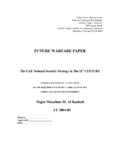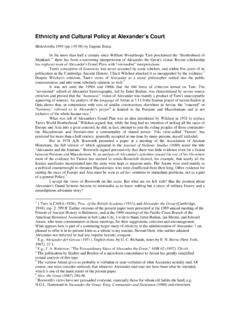Transcription of Holistic Education values
1 For the Third Annual Conference on Education , Spirituality and the Whole Child at the Roehampton Institute, London; exploring the question, Whose values are shaping Education ? . values IN Holistic Education . The Holistic Education movement does not have a single source, a predominant proponent, or a major form of expression. Consequently, it is difficult to define Holistic Education . However, there are a number of values and perceptions that most schools claiming to be Holistic would embrace, and today I would like to mention some of these values and look especially at what gave rise to their popularity. I feel that what gave rise to their popularity is particularly important because it is a combination of new perceptions and values which seems to be something like an international grass roots movement a movement which rejects many of the authorities as well as the values and perceptions of the immediate past. Whose values ? for Holistic Education , is a particularly relevant question.
2 Today I will put forward the view of many Holistic educators: that Holistic Education reflects and responds more fully than conventional Education to a new and increasingly accepted view of what it means to be human as well as to much popular social criticism. For schools to ignore what seems to be a change in humanity's view of itself is to risk having schools that try to prepare students for something they don't believe in; it is to risk having an educational system that is felt to be meaningless by the very population it wants to serve. For schools to have values and views of human nature different to those of its population is like asking a committed pacifist to attend a military academy. We see just this kind of dissonance frequently expressed in many of our schools whose populations come largely from some minority groups. These groups feel the conventional Education their children are offered does not reflect their values and it ignores their views of who they feel they are.
3 The large number of students presently disaffected with school must challenge us as educators to reflect whether these students feel a similar dissonance with the values and perspectives our schools promote. While some advocates claim that views central to Holistic Education are not new but are, in fact, timeless and found in the sense of wholeness in humanity's religious impetus; others claim inspiration from Rousseau, Emerson, Pestalozzi, Froebel, and more recently Krishnamurti, Steiner, Montessori, Jung, Maslow, Rogers, Paul Goodman, John Holt, Ivan Illich, Paulo Freire. Still others feel that the views central to Holistic Education are the result of a cultural paradigm shift that began in the 1960's. What is clear is that the values and the vision of humanity in the Holistic Education movement and which it promotes are increasingly popular. There are now at least seven thousand five hundred Holistic schools1 with more seeming to start every week. Unfortunately, the insights of this vision are often clouded by misty-eyed 1.
4 A survey of alternative schools found almost 7500 schools but this writer knows of schools that are not in that list and there are without doubt many others. Jerry Mintz (ed.), The Handbook of Alternative Education (New York: Macmillan, 1994). values in Holistic Education 2. New Ageism, and a great deal that is valuable is dismissed because of this association. I will concentrate today on developments in the 1960's and 1970's that forced some of the ideas of Holistic Education onto centre stage because it was these developments that made the ideas so popular. The ecological crisis, the prospect of nuclear annihilation, chemical and radiation pollution, the breakdown of the family, the disappearance of traditional communities, and the disregard for traditional values and their institutions ( , the church), caused many people to question the direction of the modern western world and many of its central values . The consumer society was criticised in a way that seemed to be absent in the first sixty years of this Even if some societies seemed able to continue their consumption from a local perspective, the earth's resources were beginning to be seen as finite; and a small proportion of the world's population consuming a disproportionate percentage of the earth's resources was seen as unsustainable and destructive ultimately it becoming a moral issue.
5 Mechanistic utilitarian rationality (as scientific thinking was called by its critics) was acknowledged for its contribution to the creation of clever gadgets but blamed for uncontrolled economic and technical growth that seemed to swamp other human capacities. Because scientific thinking on its own lacked the non-rational (as opposed to irrational) or supra-rational' capacities of mind such as wisdom, intuition, appreciation for beauty and insight, it was seen as most commonly used to create brilliant weaponry or unnecessary consumer goods. The supra-rational' capacities were seen as increasingly important in view of what unrestrained mechanical thought was producing. Small is Beautiful by Schumacher3 and the works of Wendell Berry seemed to fly in the face of convention, yet made perfect sense to hundreds of thousands. The professional view of human nature was also changing drastically at this time. The Skinnerian view of a person as an electro-chemical stimulus-response machine (so helpful to the needs of governments during the war and so popular with those who saw conditioning of others as a solution to their own aspirations) was being rejected as only a very partial view of the mind.
6 Behaviourism seemed more of a tool for exploiting people than for understanding them in any depth. In the wake of the many explorations into consciousness of the 1960's, Freud's very compartmentalised views of the mind lost popularity while Jung's more open ended and mysterious understandings gained support. Carl Rogers, Abraham Maslow, and Laing became almost cult figures, and several new forms of psychology emerged that took the science of mind further and further away from the strictures of conventional measurable science. Gestalt therapy with its slogan the whole is greater than the sum of its parts corresponded to the everyday common sense experience that many people had of themselves. There seemed to be too much of us that is immeasurable 2. One commentator on the development of American culture said that Americans changed from wanting to do good, to wanting to do well, but this criticism could equally be levelled at many modern cultures. The great depression and the two world wars are seen as traumas that produced an extreme materialism in the survivors.
7 3. Schumacher, Small is Beautiful: A Study of Economics as if People Mattered (London: Blond &. Briggs, 1973). Scott H. Forbes values in Holistic Education 3. and non-mechanical, if not ineffable. The view of mind as machine, while increasingly popular as a model of some thinking, especially that involving computers,4 was seen as only a part of the mind's functioning - usually the lesser part. Traditional nationalism and localism were also being challenged, and were seen as inadequate to meet the world's realities. The ecological crisis is not a respecter of political boundaries. The greenhouse effect, the depletion of the ozone layer, air and water pollution, radiation leaks, and the elimination of species and rain forests are perhaps national or local in origin but they are global in impact. People began to see that by serving national or local interests these problems could not even be understood, much less solved. The earth had to be seen as a whole, and Lynn Margulis' and James Lovelock's Gaia Hypothesis found wide and popular Environmental interest went from being a gentleman/sportsman's concern for conservation (usually to maintain hunting) to a critique of modern western thinking.
8 The epistemology which claims to understand things by breaking them into their constituent parts was seen as not only unable to meet the problem, it was part of the problem. Creating locally wanted conditions and looking only locally seemed often to produce problems elsewhere that eventually became unwanted local conditions. Wholism, whole earth ideas, wholefoods, and the whole child described things that might not have always been fully examined but which seemed to many people to make sense. People began to feel they needed to look at the global to see the local. Years after the Gaia Hypothesis, educators and ecologists like David Orr and Gregory Cajete suggested that seeing the interconnectedness of all things with nature as the foundation was the basis of a new mind that the world needed for its survival, and that the creation of this mind is the first responsibility of Many people began saying that looking at wholes was necessary to understand other things as well; the economy (which had become global), human interchange (where satellites and computers had made the global village a reality), and cultures (which were increasingly international).
9 It is not without reason that some nationalities like the French speak of cultural imperialism and find difficulty in countering a movement that is literally coming at them from all directions (even if the origin seems to be Hollywood). The youth culture is global. The computer culture is global. Many modern cultural icons (such as media stars and products) are global. One doesn't need to see the six foot tall blonde fashion models in Japan, or jeans-clad Marlboro-smoking teenagers in Mongolia, or Coca Cola drinking farmer's wives in Uzbekistan to know this is true; the evidence is constantly before us. Many post- modern philosophers had been telling us we are socially constructed, but the society that was seen as constructing us had become an international one, and many of the values that were imbedded in this construction seemed alien to the places in which they were being lived. Many cultural institutions (like schools) assumed a local culture, but the culture of the young was not local, and the conflict between the young and the institutions that claimed to exist for them was painful for everyone.
10 4. A fascinating study of the way in which computer use has altered the way people see themselves can be found in the book by Sherry Turkle, The Second Self: Computers and the Human Spirit (New York: Simon & Schuster, 1984). 5. James Lovelock, Gaia: A New Look at Life on Earth (New York: Oxford University Press, 1979). 6. David Orr, Ecological Literacy: Education and the Transition to a Post-modern World (Albany: State University of New York Press, 1992). Gregory Cajete, Look to the Mountain: an ecology of indigenous Education (Durango, Colorado: Kivaki Press, 1994). Scott H. Forbes values in Holistic Education 4. Looking at wholes (or what some scientists came to call the systems approach ). began to be seen as necessary for understanding even traditional disciplines. Respected scientists such as David Bohm, David Peat, Karl Pribram, and Ilya Prigogine were even insisting that seeing things as systems (or wholes within wholes). was a better way to understand their traditionally reductionist disciplines as well as most other things.





